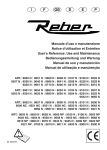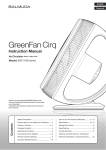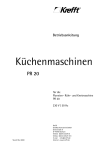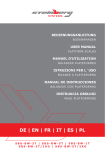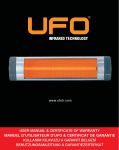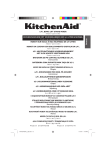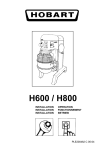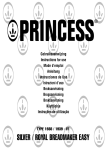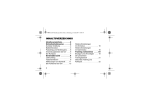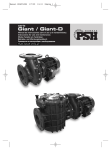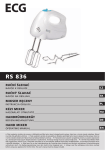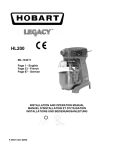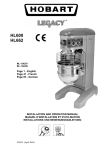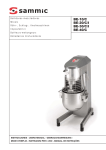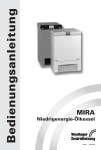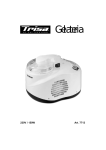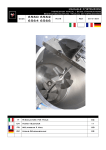Download Model HS10 - Whaley Food Service
Transcript
Model HS10 ML-134371 Page 1 - English Page 20 - French Page 39 - German INSTALLATION AND OPERATION MANUAL MANUEL D’INSTALLATION ET D’UTILISATION INSTALLATIONS UND BEDIENUNGSANLEITUNG 701 S. RIDGE AVENUE, TROY, OHIO 45374-0001 00-1-937-332-3000 WWW.HOBARTCORP.COM F 37202 (March 2008) English / Contents Section 1.0 1.1 1.2 1.3 2.0 3.0 4.0 4.1 4.2 5.0 5.1 5.2 5.3 6.0 6.1 Fig. 1 7.0 9.0 10.0 11.0 11.1 11.2 12.0 13.0 14.0 14.1 15.0 Table 1 16.0 17.0 18.0 19.0 20.0 20.1 20.2 20.3 20.4 20.5 21.0 22.0 23.0 24.0 Safety Information Safety Guidelines Warning Symbols Liability Foreword General Information Caring for Our Environment Packing Material Disposal of Your Old Appliance Safety Instructions Dust Hazard Never Always Using the Mixer Operating for the First Time Mixer Component Identification Controls Bowl Placement Agitator Bowl Guard Remove Bowl Guard Install Bowl Guard Mixing Capacity Chart Agitators Cleaning Cleaning After Use Installation and Commissioning Technical Information Unpacking and Handling Location Electrical Installation Operator Training Mixer Maintenance Lubrication Slideways Planetary Seal Measure and Adjust Agitator Clearance Interlock Safety System Fault Finding Recommended Spares Notes Service Contact Numbers © Hobart 2008 –2– Page 3 3 3 4 4 4 4 4 4 5 5 5 6 6 6 7 8 8 9 9 9 9 10 11 11 11 12 13 13 14 14 14 15 15 15 15 15 16 16 17 18 19 1.0 SAFETY INFORMATION. The procedures and precautions contained in this manual are understood to apply to the machinery only when it is used in the prescribed manner. If the machinery is used other than in the recommended manner, the operator will be responsible for his/her own safety and for the safety of the other persons who may be involved. The information in this manual has been prepared to assist the operator to understand, maintain, and operate the mixer. In order to prevent accidents, read, understand and follow all the precautions and warnings contained in this manual before installation or operating for the first time. This manual must be studied to obtain a clear understanding of the mixer and its capabilities. 1.1 SAFETY GUIDELINES. Ensure sufficient precautions are observed during manual handling of the mixer particularly when moving into position on installation. Reference must be made to manual handling regulations. The mixer weights are given in Table 1. • Do not hose or pressure clean this appliance. It is vital to adhere to the cleaning instructions detailed in section 14 of this manual. • Do not remove any covers or loosen any fittings whilst the machine is operating. • Ensure this manual is kept in an easily accessible place for future reference near the mixer. • All operators must be trained in the safe operation of the mixer and attachments. • Ensure that the power supply cord has been unplugged before attempting to service or move the mixer. • Rotating machinery and electricity are potentially hazardous and may cause injury if sufficient precautions are not taken prior to operating or servicing the machine. • Always have your mixer and attachments regularly serviced; at least twice a year, depending on frequency of use. • When mixing products that develop dust care must be taken. Mix the ingredients using the BLEND facility until the dust is eliminated. • Exposure to dust (including flour) may be harmful to health causing rhinitis (running noses), watering eyes and possibly occupational asthma. 1.2 WARNING SYMBOLS. To identify the safety messages in this manual, the following symbols have been used: The "Warning" symbol is found primarily where the corresponding information is important for the safe use of the machinery. The electrical hazard symbol is used when there are risks of an electrical nature. Prior to servicing the machinery, always disconnect the power cable from the mains supply. –3– 1.3 LIABILITY. Installations and repairs which are not carried out by Authorised technicians or the use of other than original spare parts, and any technical alterations to the machine, may affect the warranty set out in the standard conditions of sale. 2.0 FOREWORD. Hobart reserves the right to alter the design of their products without prior notice. Whilst every effort is made to ensure this publication reflects the latest design, the Company cannot guarantee full compliance. Take pride in your HS10 Mixer - keep it clean and in good mechanical and electrical condition. 3.0 GENERAL INFORMATION. The information and instructions contained in this manual may not cover all details or variations in the equipment, nor provide for every eventuality to arise with installation, operation, or maintenance. If additional information is required, please contact your local Hobart office. The HS10 Mixer is designed to mix food products as detailed on the specification chart (Section 12.0, page 10). The Hobart 10-litre mixer is a bench-type mixer which features a manual bowl lift. The machine is rated to operate on the electrical supplies shown in Table 1, page 13. The Mixer is fitted with a "no volt release" safety feature to prevent automatic restarting after a supply failure or disconnection from the mains. The bowl and the guard are interlocked so that when either is not in their correct operating positions, the mixer will not work. The standard mixer is delivered with guard, bowl and agitators. 4.0 CARING FOR OUR ENVIRONMENT. 4.1 PACKAGING MATERIAL. The pallet and protective packing material have been selected from materials that are environmentally friendly for disposal or can normally be recycled. Instead of throwing them away, please ensure they are recycled. 4.2 DISPOSAL OF YOUR OLD APPLIANCE. Old appliances contain materials that can be recycled. Please contact your local waste collection centre; scrap merchant or local Hobart office about potential recycling schemes. –4– 5.0 SAFETY INSTRUCTIONS. A FULLY TRAINED AND COMPETENT PERSON MUST ONLY USE THE MIXER. The following instructions must be observed when using the mixer. Note: The mixer must only be used for the purpose it was designed and inline with the supplied operating instructions. 5.1 DUST HAZARD. In order to minimise any dust hazard follow the instructions detailed below. When mixing ingredients care must be taken to avoid the inhalation of dust particles e.g. flour. Reference should be made to product supplier's data sheets to ensure adequate precautions/protections are taken. Items such as flour must be added in such a manner to avoid dust particles being dispersed into the local atmosphere. Carefully slit the bag whilst holding in the lower part of the bowl. When mixing dry ingredient use the lowest speed to minimise dust emission. Mix the ingredients in the bowl using the lowest speed until the risk of producing any dust is eliminated. Fit suitable dust extraction equipment. 5.2 NEVER. • Operate the mixer or attachments if a fault develops or the mixer is unsafe. • Wear loose clothing. • Attempt to reach into the bowl when mixing. • Access rotating parts. • Fit the agitator to the mixer without a bowl in place. • Leave the agitator on machine without the bowl being fitted. • Use excessive force when operating which could affect the stability of the mixer. • Operate the mixer if parts are disassembled. • Over ride the safety switches fitted to the mixer. • Open the guard to stop machine. • Use the bowl lift to stop machine. • Use the mixer in an unsafe condition. –5– • Clean the mixer with scouring powder or a scouring pad. • Clean aluminium agitators in dishwashers. • Inhale mixing ingredient dust particles. 5.3 ALWAYS. • Use the mixer in a well-lit area. • Ensure the bowl, agitator and guard are correctly fitted to the mixer. • Disconnect the mains electricity supply before cleaning the mixer. • Clean the mixer daily. • Stop mixer before adding more ingredients. • Use the stop button to stop machine. • Clean the bowl and agitators after use. • Clean the mixer using mild soap and water. • Service the mixer at least twice a year depending on the frequency of use. • Use the mixer as intended and inline with the operating instructions. 6.0 USING THE MIXER. 6.1 OPERATING FOR THE FIRST TIME. Prior to installation, test the electrical service to assure that it agrees with the specifications on the machine data plate. Place the mixer on a suitable sturdy level surface. There should be adequate space around the mixer for the user to operate the controls and to install and remove bowls. Holes are located in the base to permanently secure the mixer, although this is not necessary in normal installations. This food mixer is only for professional use by suitably trained persons. Ensure operators have read and understood this manual and have received adequate training. Moving agitator in bowl. Keep hands, clothing, and utensils out while in operation. Do not use without interlocked guard. –6– –7– 7.0 CONTROLS STARTS MIXER SPEED SELECTOR TIME SELECTOR STOPS MIXER • Push-button START and STOP buttons control power to the mixer. • The Bowl Guard must be in place and closed or the mixer will not operate. • If the Bowl Support is not all the way up, the mixer will not operate. The TIMER is used in conjunction with the START button for timed mixing operations and will stop the mixer when the desired time has elapsed. For Non-Timed Mixing — Set the timer on HOLD and use the STOP button to turn the mixer off. The SPEED SELECTOR (Fig. 2) is used to change speeds. To change speeds, turn the SPEED SELECTOR to the desired speed. Speed can be set when mixer is on or off. BLEND The slowest speed to incorporate ingredients. Speed 1 (Low) For light dough, heavy batters, or potatoes. Speed 2 (Medium) For cake batters or some whipping operations. Speed 3 (Medium-High) For light work, such as whipping cream, beating eggs, or mixing thin batters. Speed 4 (High) This speed is for maximum and accelerated air incorporation into light batches. The BOWL LIFT HANDLE (Fig. 1, page 7) is used to raise and lower the bowl. To raise the bowl, rotate the handle upward; rotating the handle downward lowers the bowl. 9.0 BOWL PLACEMENT The bowl must be installed before the agitator. To install the bowl, fully lower the bowl support (Fig. 3). Position the bowl so two large holes on bowl tabs are above the bowl pins on the bowl support. Lower the bowl onto bowl pins, then turn clockwise until stopped in locked position. Fig. 3 –8– 10.0 AGITATOR To install an agitator (Fig. 1, page 7), the bowl must be installed and fully lowered. Place the agitator in the bowl, push it up on the agitator shaft, and turn it clockwise to seat the shaft pin in the slot of the agitator shank. Fig. 4 11.0 BOWL GUARD Bowl guard must be in position and closed in order to mix. If bowl guard is opened during the mixing, mixer will stop. 11.1 REMOVE BOWL GUARD Lower the bowl support and remove agitator before removing bowl guard. Hold bowl guard with both hands and pull downward gently to release bowl guard from retaining groove. 11.2 INSTALL BOWL GUARD Hold bowl guard with both hands and gently push upward until bowl guard is latched onto the retaining groove and can be rotated freely. –9– 12.0 Mixing Bowl Capacity Chart - HS10 Capacity of Bowl (Qts. Liquid) Model Motor (HP) Small Bowls Available as Extras Overall Space Required (Floor) 10-Quart HS10 .45 Agitators Suitable for Operation 13 21/32W X 17 9/32D X 25 5/8H Kitchen Materials Capacity Chart (Finished Materials) Egg Whites (pt.) Mashed Potatoes (lbs.) Mayonnaise (Qts. of Oil) Meringue (Qty. of Water) Waffle or Hot Cake Batter (qt.) Whipped Cream (qt.) D B B or D D B D 1 pt. 8 lbs. 4 qts. 3/4 pt. 4 qts. 2 qts. B B B B B B ED ED B ED ED ED ED ED B B B B ED 7 1/2 lbs. 10 lbs. 18 doz. 15 lbs. 6 lbs. 9 lbs. 12 lbs.** 5 lbs.** 12 lbs. 4 lbs.** 5 lbs.** 8 lbs.** 4 1/2 + lbs. 8 lbs.** 4 lbs. 6 lbs. 1 lbs. 8 lbs. 3 lbs. Bake Shop Materials Cake, Angel Food (8-10 oz. cake) (lb.) Cake, Box or Slab or Layer (lb.) Cake, Cup (doz.) Cake, Pound (lb.) Cake, Sponge (lb.) Cookies, Sugar (lbs.) Dough, Bread or Roll (Lt-Med) 60% AR § (lb.) Dough, Heavy Bread 55% AR § (lb.) Dough, Pie (lb.) Dough, Thin Pizza 40% AR (max mix time 5 min.) § Dough, Medium Pizza 50% AR § Dough, Thick Pizza 60% AR § Dough, Raised Donut 65% AR (lb.) Dough, Whole Wheat 70% AR Eggs & Sugar for Sponge Cake (lb.) Icing, Fondant (lb.) Icing, Marshmallow (lb.) Shortening & Sugar, Creamed (lb.) Pasta, Basic Egg Noodle (max mix time 5 min.) (lb.) ABBREVIATIONS - AGITATORS SUITABLE FOR OPERATION B - Flat Beater D - Wire Whip ED - Dough Arm ** 1st Speed + 2nd Speed NOTE: % AR (% Absorption Ratio) = Water weight divided by flour weight X 100%. Capacity depends on moisture content of dough. Above capacity based on 12% flour moisture and 70 F water temperature. o § If high gluten flour is used, reduce above dough batch size by 10%. – 10 – 13.0 AGITATORS The B Flat Beater is a multi-purpose agitator used for mashing potatoes or other vegetables, and mixing cakes, batters or icings. It is also used in industrial applications for any product requiring a creaming or rubbing action and uniform dispersion of ingredients. Use first speed for starting most operations; medium speed for finishing. The D Wire Whip is designed for maximum blending of air into light products. Uses include: whipping cream, beating egg whites, mixing very light icings, meringues and all similar applications. The D Wire Whip is most commonly used in third and fourth speed. The ED Dough Hook is used for mixing most bread, roll and pizza dough, which require folding, and stretching action for best development. These agitators are suitable for use on all yeast raised doughs and commonly used in first or second speed. 14.0 CLEANING. Cleaning New Mixer Bowls and Accessories - Before using the first time, thoroughly wash new mixer bowls and agitators (beaters, whips and dough hooks). Wash in hot water and a mild detergent solution, rinsing with either a mild soda or vinegar solution, and thoroughly rinse with clear water. Also follow this cleaning procedure for bowls and agitators before whipping egg whites or whole eggs. 14.1 CLEANING AFTER USE. After use, clean the mixing bowl and agitators with hot water, using a suitable non-abrasive detergent and soft bristle brush. (Flushing the bowl with hot water immediately after use will ease the cleaning). Note: Do not clean the aluminium agitators in a dishwasher. The mixer should be thoroughly cleaned daily. Do not use a hose to clean the mixer; it should be washed with a clean, damp cloth. The base allows ample room for cleaning under the mixer. For cleaning the Bowl Guard, refer to Section 11.1. – 11 – 15.0 INSTALLATION AND COMMISSIONING. Fig. 6 – 12 – Table 1. Technical Information. Description Mixer power Maximum speed of rotating part (50Hz) Nominal electrical supply 1 ph Full load current at above voltage 1 ph Locked rotor current at above voltage 1 ph Recommended fuse size 230v/1 ph/50Hz Minimum ambient temperature Maximum ambient temperature Transmission case lubricating grease capacity Mixer weight (Bowl Included) Bowl weight (10 litre) Agitator weight (10 litre beater) Noise level Shipping weight (Bowl included) Shipping dimensions (carton) Storage conditions. Temperature and humidity. Class of appliance Enclosure IP rating Units kW (hp) rpm Volts Amps Amps Amps oC oC Litres Kg (lbs) Kg (lbs) Kg (lbs) dB (A) kg (Lbs) LxWxH cm oC, % RH HS10 0.34 (0.45) 2500 200-240 2.9 10 10 0 40 0.8 85.7 (189) 4.2 (9.3) 0.95 (2.1) less than70## 92.5 (204) 62.8 x 57.8 x 87.3 +5 to +38, 85 Class 1# IP32 # Refer to Section 18.0 ## In accordance with EN-ISO 12001:1996. 16.0 UNPACKING AND HANDLING. Wherever possible the food mixer should be transported to the installation position in the packaging provided to avoid damage. Do not use a sharp knife to cut into the box as damage to the machine may occur. Check for possible shipping damage. If the unit is found to be damaged, save the packaging material and contact your nearest Hobart sales office. The HS10 mixer is a heavy object and must be correctly handled and lifted to avoid personal injury. Refer to Table 1 for weights and dimensions. For UK installations refer to the ‘Manual Handling Operations Regulations 1992 and HSE guidance notes for manual handling. With the machine in the vicinity of its final position, remove from outer carton. Remove mounting bolts under skid attached to mixer base. Remove mixer from skid forking from the side of unit. When moving unit, always fork from side of unit. Care must be taken during this operation to ensure: – 13 – a. All required safety measures are taken to ensure correct lifting and handling to avoid risk of injury through dropping, falling and tilting. b. No damage occurs to the machine, which could impair the normal operation. 17.0 LOCATION. The mixer is not suitable for outdoor installation and must not be installed where a water jet could be used for cleaning. The mixer must only be operated by trained staff and must be installed in an area where the use and maintenance is restricted to trained personnel. The mixer must be installed on a horizontal flat surface level to a minimum of 1mm in 1 metre side to side and front to back. Select a suitable flat level surface that can support the weight of the mixer and bowl contents when full (refer to Table 1 for weights and dimensions). In areas where stability may be an issue, the machine should be secured in position. Ensure there is sufficient space around the mixer for the user to operate the controls and to install and remove bowls. The area above and to the rear side of the mixer should allow the top and bottom covers to be removed for routine maintenance and servicing. Servicing may be more difficult because of reduced clearances and you should always check that equipment specifications permit the close proximity of other equipment. Refer to Fig. 6, page 12 for the overall dimensions of the mixer and the clearance required to accommodate the bowl. 18.0 ELECTRICAL INSTALLATION. The electrical installation of the mixer must conform to the local electricity board regulations. When installed in the United Kingdom the installation must be in accordance with the current edition of the IEE Regulations for electrical equipment in buildings and must conform to the requirements of the Electricity at work act. A competent person must carry out the electrical installation. The technical data shown in Table 1, page 13 details the electrical requirements for the mixer. Ensure that the electrical power supply agrees with the machine specification prior to connection. The mixer is equipped with a three-wire power supply cord ready for installation of an appropriate grounding-type attachment plug. The plug and its mating receptacle must be properly grounded. Contact an electrician. Provide proper fuse or circuit breaker protection. 19.0 OPERATOR TRAINING. Take time to explain the correct operation and cleaning of the HS10 mixer to the users referring to this manual. Leave this manual with the operator and explain that it is important to use it for further reference. – 14 – 20.0 MIXER MAINTENANCE. A Hobart trained and competent person should carry out servicing. Do not remove any covers or loosen any fittings while the mixer is operating. Ensure the electrical supply has been isolated before attempting to service or move the mixer. Unplug machine power cord before beginning any maintenance procedures. 20.1 LUBRICATION. 20.2 SLIDEWAYS. The slideways (Fig. 7) should be lubricated approximately twice a year. To reach these areas, fully lower the bowl support. Wipe a thin coat of Lubriplate 630AA on the bowl pad area of the bowl supports and on each slideway. Refer to the recommended spare parts section for Lubriplate grease part number. Adjusting Screw Slideway 20.3 PLANETARY SEAL. Seal requires occasional lubrication. 20.4 MEASURE AND ADJUST AGITATOR CLEARANCE. A proper clearance between the bowl and agitator is important since an excessive clearance will affect mixer performance and since contact between the bowl and agitator will damage these components. Therefore, agitator clearance should be checked periodically. Proper agitator clearance between the bowl and B flat agitator, at the bottom of the bowl, is 9.5 mm (.0375 in.). To check clearance, pour enough flour into the bowl to cover the bottom of the bowl. With the bowl raised and locked in the mixing position, make sure that agitator does not contact the bowl, then briefly operate the mixer at the lowest speed. Turn off the mixer, disconnect the electrical power supply, and measure the depth of flour at several points around the bottom of the bowl where the agitator has traced a path. If adjustment is needed, use the adjusting screw, as shown in Fig. 7, to adjust the bowl up or down. – 15 – 20.5 INTERLOCK SAFETY SYSTEM. Regular inspection of the mixer safety system is necessary to check the operation of the bowl, guard and bowl support interlock switches. This must be performed no less than once a year. A spare parts manual is available on request from Hobart Spare Parts Distribution Centre. For continued safe and reliable operation of this mixer, it is recommended that servicing is only carried out by Hobart trained service personnel. 21.0 FAULT FINDING. Symptoms Mixer will not start. Agitator touches bowl. Planetary seal squeaks. Possible Causes Branch circuit protector is in open position - check fuse or disconnect switch. Mixer is overloaded. Wire cage is not in the closed position. Bowl is not in up (mix) position. Timer is not properly set to HOLD or not away from OFF position. Improper agitator clearance - see Mixer Maintenance for Adjustments. Stop screw is not adjusted properly - see Mixer Maintenance for Adjustments. Agitator is not installed properly. Seal requires occasional lubrication - see Maintenance. – 16 – 22.0 RECOMMENDED SPARES. Part Number 00-916864 00-916932 00-917141 00-916867-2 00-916984 00-916982 00-917184 00-916902-4 00-916842 00-916986-2 00-916916 00-478189 00-917106 00-478106 00-916901 00-916931 00-917185 00-917186 00-917260 00-478191-2 00-916988-2 00-917147-1 Description Switch - Start Switch - Stop Assembly Knob Motor - DC 180V Cage - Weldment Ring, Drip Holder, Reed Switch Switch, Reed-fused Assembly Bowl - 10 Litre "B" Beater - 10 Litre "D" Wire Whip - 10 Litre "ED" Dough Arm - 10 Litre Ingredient Chute Belt, Poly V 10 Qt PCB, Speed Select Switch, Reset 220V Magnet Holder, Magnet Cord, Strain Relief Speed Control 180V Timer, 230V, 60 Hz, 15 Min Filter, Power Line – 17 – 23.0 NOTES. – 18 – 24.0 SERVICE CONTACT NUMBERS. Hobart trained service technicians strategically located throughout the UK are prepared to give you fast, efficient and reliable service. Protect your investment by having a Hobart inspection contract, which assures the continued, efficient operation of your Hobart machines, spares and accessories. For disposal of mixer, contact Hobart Service Centre for return details. For further details please contact: Department SALES: SERVICE SPARES Telephone 07002 101 101 07002 202 202 07002 303 303 Facsimile 02088 864 396 01733 371 709 01733 371 332 Continued product improvement is a Hobart UK policy, specifications may change without notice. Hobart UK Hobart House, 51 The Bourne, Southgate, London N14 6RT Tel: 07002 101101 Fax 0208 886 4396 F-37202 (March 2008) – 19 – Modèle HS10 ML-134371 Page 1 - Anglais Page 20 - Français Page 39 - Allemand INSTALLATION AND OPERATION MANUAL MANUEL D’INSTALLATION ET D’UTILISATION INSTALLATIONS UND BEDIENUNGSANLEITUNG 701 S. RIDGE AVENUE, TROY, OHIO 45374-0001 00-1-937-332-3000 WWW.HOBARTCORP.COM F 37202 (Mars 2008) – 20 – Français / Sommaire Informations de sécurité Consignes de sécurité Symboles d’avertissement Responsabilité Avant-propos Informations générales Respect de l’environnement Matériaux d’emballage Élimination de votre ancien dispositif Consignes de sécurité Dangers relatifs à la poussière Ne jamais… Toujours… Utilisation du mixeur Première utilisation Identification des composants du mixeur Commandes Mise en place du bol Agitateur Système de protection du bol Retrait du système de protection du bol Installation du système de protection du bol Tableau de capacité du mixeur Agitateurs Nettoyage Nettoyage après utilisation Installation et mise en service Caractéristiques techniques Déballage et manipulation Emplacement Raccordements électriques Formation de l’utilisateur Entretien du mixeur Lubrification Glissières Joint planétaire Mesure et réglage du dégagement de l’agitateur Système de verrouillage de sécurité Dépannage Pièces de rechange recommandées Remarques © Hobart 2008 – 21 – Section 1.0 1.1 1.2 1.3 2.0 3.0 4.0 4.1 4.2 5.0 5.1 5.2 5.3 6.0 6.1 Fig. 1 7.0 9.0 10.0 11.0 11.1 11.2 12.0 13.0 14.0 14.1 15.0 Tableau 1 16.0 17.0 18.0 19.0 20.0 20.1 20.2 20.3 20.4 20.5 21.0 22.0 23.0 Page 22 22 22 23 23 23 23 24 24 24 24 24 25 25 26 26 27 27 28 28 28 28 29 30 30 30 31 32 32 33 33 34 34 34 34 34 35 35 35 36 37 1.0 INFORMATIONS DE SÉCURITÉ Les procédures et les précautions de sécurité contenues dans ce manuel sont valables pour l’appareil seulement lorsque celui-ci est utilisé conformément aux indications. Si le dispositif n’est pas utilisé conformément aux indications, l’utilisateur sera tenu pour responsable de sa propre sécurité et de la sécurité de toute autre personne concernée. Les informations fournies dans ce manuel ont été élaborées pour aider l’utilisateur à comprendre, entretenir et utiliser le mixeur. Afin d’éviter tout accident, veillez à bien lire, comprendre et suivre l’ensemble des instructions et avertissements contenus dans ce manuel avant l’installation ou la première utilisation. Ce manuel doit être étudié afin de comprendre clairement le fonctionnement du mixeur ainsi que ses capacités. 1.1 CONSIGNES DE SÉCURITÉ Assurez-vous que des précautions suffisantes sont observées lors de la manipulation du mixeur, et tout particulièrement au moment de sa mise en place. Référez-vous aux règlements relatifs à la manipulation. Les poids du mixeur sont indiqués dans le tableau 1. • Ne nettoyez pas cet appareil au jet ou sous pression. Il est essentiel de suivre rigoureusement les consignes de nettoyage détaillées dans la section 14 de ce manuel. • Ne retirez aucun couvercle et ne détachez aucun accessoire en cours de fonctionnement de l’appareil. • Assurez-vous de conserver ce manuel dans un endroit facile d’accès à proximité du mixeur afin de pouvoir vous y référer ultérieurement. • Tous les utilisateurs doivent être formés pour une utilisation sûre du mixeur et de ses accessoires. • Assurez-vous que le cordon secteur est débranché avant d’entretenir ou de déplacer le mixeur. • Les éléments rotatifs de l’appareil ainsi que l’électricité constituent un danger potentiel et peuvent entraîner des blessures si des précautions suffisantes ne sont pas prises avant l’entretien ou l’utilisation de la machine. • Entretenez régulièrement votre mixeur et ses accessoires ; au moins deux fois par an, selon la fréquence d’utilisation. • Lorsque vous mixez des produits générant de la poussière, soyez vigilants. Mixez les ingrédients en utilisant la fonction BLEND [MÉLANGE] jusqu’à élimination complète de la poussière. • L’exposition à la poussière (y compris à la farine) peut être dangereuse pour la santé et causer rhinites (nez qui coule), larmoiement et éventuellement asthme professionnel. 1.2 SYMBOLES D’AVERTISSEMENT Afin d’identifier les messages de sécurité dans ce manuel, les symboles suivants ont été utilisés : – 22 – Le symbole "Warning" [Attention] correspond principalement aux informations importantes pour une utilisation sûre de l’appareil. Le symbole de danger relatif à l’électricité est utilisé lorsqu’il existe un risque de nature électrique. Avant d’effectuer des réparations sur l’appareil, déconnectez toujours le cordon d’alimentation du secteur. 1.3 RESPONSABILITÉ Les installations et les réparations qui ne sont pas effectuées par des techniciens habilités ou l’utilisation de pièces autres que les pièces de rechange originales, ainsi que toutes altérations de la machine, peuvent affecter la garantie établie dans des conditions de vente standard. 2.0 AVANT-PROPOS Hobart se réserve le droit de modifier la conception de ses produits sans préavis. Malgré tous nos efforts pour vous garantir que cette publication correspond à la toute dernière conception, la société ne peut garantir une conformité totale. Entretenez avec soin de votre mixeur HS10 : veillez à ce qu’il reste propre et en bon état mécanique et électrique. 3.0 INFORMATIONS GÉNÉRALES Il est possible que les informations et les instructions contenues dans ce manuel ne couvrent pas tous les détails ou variantes de l’équipement, ni toutes les éventualités pouvant se produire lors de l’installation, de l’utilisation ou de l’entretien. Si vous avez besoin d’informations supplémentaires, veuillez contacter votre bureau Hobart le plus proche. Le mixeur HS10 est conçu pour mixer des produits alimentaires comme indiqué dans le tableau de spécifications (Section 12.0, page 29). Le mixeur Hobart 10 litres est un mixeur de table équipé d’un levier de bol manuel. L’appareil est conçu pour un fonctionnement avec les alimentations électriques indiquées dans le tableau 1, page 32. Le mixeur est équipé d’un dispositif électrique de sécurité afin d’empêcher le redémarrage automatique après une panne d’alimentation ou un débranchement du secteur. Le bol et le système de protection sont enclenchés ensemble, de façon à ce que si l’un des deux n’est pas dans la position correcte d’utilisation, le mixeur ne fonctionne pas. Le mixeur standard est livré avec protection, bol et agitateurs. 4.0 RESPECT DE L’ENVIRONNEMENT – 23 – 4.1 MATÉRIAUX D’EMBALLAGE Les matériaux de la palette et de l’emballage protecteur ont été sélectionnés parmi des matériaux dont l’élimination est respectueuse de l’environnement et pouvant être recyclés normalement. Au lieu de jeter les emballages, recyclez-les. 4.2 ÉLIMINATION DE VOTRE ANCIEN APPAREIL Les anciens appareils contiennent des matériaux recyclables. Veuillez contacter le centre de collecte des déchets, le ferrailleur ou le centre Hobart le plus proche concernant les dispositions en matière de recyclage. 5.0 CONSIGNES DE SÉCURITÉ SEULE UNE PERSONNE FORMÉE ET COMPÉTENTE PEUT UTILISER LE MIXEUR. Les consignes suivantes doivent être observées lors de l’utilisation du mixeur. Remarque: le mixeur doit être utilisé uniquement pour la fonction pour laquelle il est conçu et conformément aux instructions de fonctionnement fournies. 5.1 DANGER RELATIF À LA POUSSIÈRE Afin de minimiser tout risque lié à la poussière, suivez les instructions détaillées ci-dessous. Lorsque vous mixez des ingrédients, vous devez être vigilants et éviter toute inhalation de particules de poussière, par exemple avec la farine. Veuillez vous référer aux fiches de données du fournisseur afin de vous assurer que les précautions adéquates sont prises et les protections appropriées mises en œuvre. Les éléments comme la farine doivent être ajoutés de façon à éviter la dispersion de particules de poussière dans l’atmosphère ambiante. A l’aide d’un couteau, ouvrez soigneusement le sac tout en le maintenant à l’intérieur du bol. Lorsque vous mixez des ingrédients secs, utilisez la vitesse la plus basse afin de minimiser les émissions de poussière. Mixez les ingrédients dans le bol en utilisant la vitesse la plus basse jusqu’à ce que le risque de production de poussière soit totalement éliminé. Installez un équipement adéquat d’extraction de poussière. 5.2 NE JAMAIS… • Utiliser le mixeur ou les accessoires si un défaut apparaît ou si le mixeur présente un quelconque danger. • Porter des vêtements amples. – 24 – • Essayer d’accéder à l’intérieur du bol en cours de mixage. • Accéder aux composants rotatifs. • Installer l’agitateur au mixeur si le bol n’est pas en place. • Laisser l’agitateur sur la machine si le bol n’est pas en place. • Faire usage de la force en cours d’utilisation, ce qui pourrait affecter la stabilité du mixeur. • Utiliser le mixeur si certains composants sont démontés. • Désactiver les interrupteurs de sécurité du mixeur. • Ouvrir le système de protection pour arrêter l’appareil. • Utiliser le levier du bol pour arrêter la machine. • Utiliser le mixeur dans des conditions non sécurisées. • Nettoyer le mixeur avec de la poudre ou un tampon à récurer. • Nettoyer les agitateurs en aluminium au lave-vaisselle. • Inhaler les particules de poussière des ingrédients mixés. 5.3 TOUJOURS… • Utiliser le mixeur dans un endroit bien éclairé. • S’assurer que le bol, l’agitateur et le système de protection sont correctement installés sur le mixeur. • Déconnecter l’alimentation secteur avant de nettoyer le mixeur. • Nettoyer le mixeur quotidiennement. • Arrêter le mixeur avant d’ajouter plus d’ingrédients. • Utiliser le bouton stop [arrêt] pour arrêter l’appareil. • Nettoyer le bol et les agitateurs après utilisation. • Nettoyer le mixeur au savon et à l’eau. • Entretenir le mixeur au moins deux fois par an selon la fréquence d’utilisation. • Utiliser le mixeur conformément à ce pour quoi il a été conçu et en suivant les instructions d’utilisation. 6.0 UTILISATION DU MIXEUR – 25 – 6.1 PREMIÈRE UTILISATION Avant l’installation, testez l’installation électrique afin de vous assurer qu’elle est conforme aux spécifications de la plaque signalétique de l’appareil. Placez le mixeur sur une surface solide et plane. Il doit y avoir un espace suffisant autour du mixeur pour permettre à l’utilisateur d’actionner les commandes et d’installer et de retirer les bols. Des trous sont prévus à la base du mixeur pour assurer une stabilité permanente, bien que cela ne soit pas nécessaire si l’installation est faite correctement. Ce mixeur d’aliments est destiné exclusivement à un usage professionnel par des personnes correctement formées. Assurez-vous que les utilisateurs ont lu et compris les instructions et qu’ils ont reçu une formation appropriée. Prenez garde à l’agitateur. Gardez vos mains, vêtements et ustensiles à l’extérieur pendant le fonctionnement. Ne pas utiliser tant que la protection n’est pas enclenchée. COMMANDES PROTECTION ANTIPROJECTIONS CAGE MÉTALLIQUE POIGNÉE DE LEVIER DU BOL SUPPORT DU BOL AGITATEUR – 26 – 7.0 COMMANDES DÉMARRER LE MIXEUR SÉLECTEUR DE VITESSE SÉLECTEUR DE DURÉE ARRÊTER LE MIXEUR • Les boutons START et STOP permettent d’allumer et d’éteindre le mixeur. • La protection du bol doit être mise en place et fermée pour que le mixeur puisse fonctionner. • Si le support du bol n’est pas mis en place correctement, le mixeur ne fonctionnera pas. Le TIMER (minuteur) est utilisé avec le bouton START pour le minutage du mixage et arrête automatiquement le mixeur lorsque le temps choisi s’est écoulé. Pour le mixage non minuté — Réglez le minuteur sur HOLD et utilisez le bouton STOP pour éteindre le mixeur. Le sélecteur de vitesse (SPEED SELECTOR) (Fig. 2) sert à régler la vitesse. Pour modifier la vitesse, tournez le bouton SPEED SELECTOR sur la vitesse voulue. La vitesse peut être réglée lorsque le mixeur est en veille ou sous tension. BLEND Vitesse la plus basse, pour ajouter les ingrédients Vitesse 1 (lent) Pour mixer les pâtes légères, les pâtes lourdes ou les pommes de terre. Vitesse 2 (moyen) Pour mixer les pâtes à gâteaux ou pour les opérations de fouettage. Vitesse 3 (rapide) Pour les opérations légères, comme fouetter de la crème, battre des œufs ou pour mixer des pâtes fines. Vitesse 4 (très rapide) Vitesse la plus élevée, pour incorporer de l’air à cadence maximale afin de mixer de petits lots. La poignée du levier du bol (BOWL LIFT HANDLE) (Fig. 1, page 26) sert à surélever et abaisser le bol. Pour surélever le bol, tournez la poignée vers le haut. Pour l’abaisser, tournez la poignée vers le bas. 9.0 MISE EN PLACE DU BOL Le bol doit être installé avant l’agitateur. Pour installer le bol, abaissez complètement le support du bol (Fig. 3). Placez le bol de façon à ce que les deux gros trous au niveau des pattes du bol soient au-dessus des chevilles du support du bol. Abaissez le bol sur les chevilles puis tournez dans le sens des aiguilles d’une montre jusqu’à ce qu’il s’enclenche. – 27 – 10.0 AGITATEUR Pour installer un agitateur (Fig. 1, page 26), le bol doit être sur son support et totalement abaissé. Placez l’agitateur dans le bol, faites-le glisser jusqu’en haut de l’axe et tournez dans le sens des aiguilles d’une montre pour placer la cheville de l’axe dans la fente de la tige de l’agitateur. Fig. 4 11.0 SYSTÈME DE PROTECTION DU BOL Pour que le mixeur fonctionne, le système de protection du bol doit être installé et fermé. Si le système de protection s’ouvre pendant le mixage, le mixeur s’arrêtera. 11.1 RETRAIT DU SYSTÈME DE PROTECTION Abaissez le support du bol et retirez l’agitateur avant de retirer le système de protection. Tenez la protection à deux mains et tirez doucement vers le bas pour libérer la protection de la rainure qui la retient. 11.2 INSTALLATION DU SYSTÈME DE PROTECTION DU BOL Tenez la protection du bol à deux mains et poussez doucement vers le haut jusqu’à ce que la protection s’enclenche au niveau de la rainure et puisse être tournée librement. – 28 – 12.0 Tableau de capacité du mixeur HS10 Capacité du bol (liquide) Modèle Moteur Petits bols supplémentaires disponibles Espace total requis (sol) Agitateurs convenant a l’operation 9,46 litres HS10 0,45 cv 62,8 X 57,8 X 87,3 Tableau de capacité pour préparations culinaires (préparations finies) Blancs d’œufs Purée de pommes de terre Mayonnaise (huile) Meringue (qté. d’eau) Pâte pour gaufres ou gâteaux chauds Crème chantilly D B B or D D B D 0,47 litres 3,63 kg 3,79 litres 0,35 litres 3,79 litres 1,89 litres B B B B B B ED ED B ED ED ED ED ED B B B B ED 3,4 kg 4,54 kg 18 6,8 kg 2,72 kg 4,08 kg 5,44 kg ** 2,27 kg ** 5,44 kg 1,81 kg ** 2,27 kg ** 3,63 kg ** 2,04 kg + 3,63 kg ** 1,81 kg 2,72 kg 0,45 kg 3,63 kg 1,36 kg Préparations pour gâteaux Gâteau de Savoie (gâteau de 225—280 g) Gâteau, boîte, grosse tranche ou couche Gâteau, individuel (douzaine) Quatre quarts Gâteau, génoise Cookies, sucre Pâte, pain ou petits pains (Léger à moyen) 60% AR § Pâte, pain lourd, 55% AR § Pâte, tarte Pâte, pizza fine 40% AR (temps de mixage max : 5 min.) § Pâte, pizza moyenne 50% AR § Pâte, pizza épaisse 60% AR § Pâte à beignet levée 65% AR (lb.) Pâte, blé complet 70% AR Œufs et sucre pour génoise Glaçage, fondant Glaçage, guimauve Matière grasse et sucre, à la crème Pâtes, pâtes basiques aux œufs (temps de mixage maximum 5 min.) ABREVIATIONS - AGITATEURS ADAPTES POUR L’OPERATION B: Batteur plat D: Fouet métallique ED – Crochet pétrisseur ** 1ère vitesse + 2ème vitesse REMARQUE: %AR (% taux d’absorption) = Poids d’eau divisé par poids de farine X 100%. La capacité dépend de la teneur en humidité de la pâte. Les capacités ci-dessus sont basées sur un taux d’humidité de la farine de 12% pour une température de l’eau de 21°C (70°F). § Si une farine à haute teneur en gluten est utilisée réduisez la taille du lot de pâte ci-dessus de 10%. – 29 – 13.0 AGITATEURS Le batteur plat B est un agitateur à usages multiples, utilisé pour écraser les pommes de terre ou d’autres légumes et pour mélanger les gâteaux, les pâtes ou les glaçages. Il est également utilisé dans les applications industrielles pour tous les produits exigeant une opération de crémage ou de friction et une répartition uniforme des ingrédients. Utilisez la première vitesse pour démarrer la plupart des opérations puis la vitesse moyenne pour les terminer. Le fouet métallique D est conçu pour un mélange d’air optimal dans des produits légers. Exemples d’utilisations : crème fouettée, œufs montés en neige, mixage des glaçages très légers, meringues et toute autre application similaire. Le fouet métallique D s’utilise le plus souvent avec la troisième et la quatrième vitesse. Le crochet à pâte ED s’utilise pour mélanger la plupart des pâtes à pain, friands et pizzas, qui nécessitent un pliage et une extension de la pâte pour un meilleur développement. Ces agitateurs conviennent pour une utilisation avec toute pâte à levain et s’utilisent généralement en première ou seconde vitesse. 14.0 NETTOYAGE Nettoyage des nouveaux bols et accessoires du mixeur – Avant la première utilisation, nettoyez les nouveaux bols et agitateurs du mixeur (batteurs, fouets et crochets pétrisseurs) à l’eau chaude et avec une solution détergente douce, rincez avec une solution légère à base de soude ou de vinaigre, puis rincez à l'eau claire. Suivez toujours cette procédure de nettoyage pour les bols et agitateurs avant de fouetter des blancs d'œufs ou des œufs entiers. 14.1 NETTOYAGE APRÈS UTILISATION Après utilisation, nettoyer le bol de mixage et les agitateurs à l'eau chaude, en utilisant un détergent approprié non abrasif, ainsi qu'une brosse à poils doux. (Un rinçage du bol à l'eau chaude immédiatement après utilisation facilitera le nettoyage). NB : Ne pas nettoyer les agitateurs en aluminium au lave-vaisselle. Le mixeur doit être nettoyé à fond tous les jours. N’utilisez pas un jet pour nettoyer le mixeur, celui-ci doit être nettoyé à l’aide d’un chiffon propre et humide. La base laisse un espace suffisant pour nettoyer sous le mixeur. Pour le nettoyage de la protection du bol, voir la section 11.1. – 30 – 15.0 INSTALLATION ET MISE EN SERVICE Fig. 6 – 31 – Tableau 1. Caractéristiques techniques Description Puissance du mixeur Vitesse maxi de la pièce rotative (50 Hz) Alimentation électrique nominale 1 ph Charge totale à la tension indiquée ci-dessus 1 ph Courant rotor bloqué à la tension ci-dessus 1 ph Taille de fusible recommandée 230V/1 ph/50Hz Température ambiante min. Température ambiante max. Capacité d'huile de lubrification du carter de transmission Poids du mixeur (bol compris) Poids du bol (10 litres) Poids de l'agitateur (batteur 10 litres) Niveau de pression acoustique Poids pour transport (bol inclus) Dimensions d'expédition (carton) Conditions de stockage. Température et humidité. Classe d'appareil Classe IP Unités kW (cv) Tr/mn Volts Ampères HS10 0,34 (0,45) 2500 200-240 2,9 Ampères Ampères oC oC Litres 10 10 0 40 0,8 Kg Kg Kg dB (A) kg L x l x h (cm) 85,7 4,2 0,95 Moins de 70## 92,5 62,8 x 57,8 x 87,3 +5 à +38, 85 Classe 1# IP32 oC, % HR # Voir section 18.0 ## Conforme à la norme EN-ISO 12001:1996. 16.0 DÉBALLAGE ET MANUTENTION Dans la mesure du possible, le mixeur alimentaire doit être transporté jusqu'au site d'installation dans l'emballage fourni afin d'éviter tous dommages. N’utilisez pas de cutter pour couper la boîte, cela peut endommager l'appareil. Vérifiez tous dommages d'expédition éventuels. S’il s’avère que l'appareil est endommagé, conservez l'emballage et contactez le bureau de vente Hobart le plus proche. Le mixeur HS10 est un objet lourd et doit être correctement manipulé et soulevé afin d’éviter toute blessure corporelle. Référez-vous au tableau 1, page 32 pour les poids et dimensions. Une fois l'appareil à proximité de son emplacement définitif, retirez-le du carton extérieur. Retirez les boulons de montage situés sous le patin fixé à la base du mixeur. Retirez le mixeur du patin par le côté de l'unité. Lors de tout déplacement de l’unité, toujours procéder au niveau du côté de l’appareil. Au cours de cette opération, restez vigilants afin de vous assurer que : – 32 – a. Toutes les mesures de sécurité requises ont été prises pour assurer un levage et une manutention corrects afin d'éviter tous risques de blessures par suite de lâchage, chute ou basculement. b. Aucun dommage ne survienne au niveau de la machine pouvant nuire à son bon fonctionnement. 17.0 EMPLACEMENT Le mixeur ne convient pas pour une installation extérieure et ne doit pas être installé à un endroit où un jet d’eau pourrait être utilisé pour le nettoyage. Le mixeur doit être utilisé exclusivement par un personnel qualifié et doit être installé dans une zone où l’utilisation et l’entretien sont réservés à du personnel formé. Le mixeur doit être posé sur une surface plane horizontale, avec un minimum de 1 mm par mètre d'un côté à l'autre et d'avant en arrière. Sélectionnez une surface horizontale plane appropriée capable de supporter le poids du mixeur et du contenu du bol lorsqu'il est plein (voir le Tableau 1 pour les poids et dimensions). Lorsque la stabilité peut être un problème, la machine doit être fixée en place. Assurez-vous qu'il y a suffisamment d'espace autour du mixeur pour que l'utilisateur puisse accéder aux commandes et installer et retirer les bols. La zone située au-dessus et à l’arrière du mixeur doit permettre de retirer les couvercles supérieur et latéral en vue d’un entretien et d’une révision périodiques. La révision peut s’avérer plus difficile en cas de réduction des dégagements et il faut toujours vérifier que les spécifications de l'équipement permettent la proximité directe d'autres équipements. Référez-vous à la Figure 5, page 28 pour les dimensions globales du mixeur HS10 et le dégagement requis pour tenir compte du bol. 18.0 RACCORDEMENTS ÉLECTRIQUES. L’installation électrique du mixeur doit être conforme aux réglementations des services d’électricité locaux. L’installation électrique doit être effectuée par une personne compétente. Les caractéristiques techniques indiquées dans le Tableau 1, page 32 indiquent en détails les exigences électriques du mixeur. Assurez-vous que la prise d’alimentation secteur est compatible avec les caractéristiques de l’appareil avant le branchement. Le mixeur est équipé d’un cordon d’alimentation trifilaire prévu pour l’installation d’une prise d’alimentation appropriée de type mise à la terre. La prise et le connecteur correspondant doivent être correctement mis à la terre. Contactez un électricien. Installez un fusible ou un disjoncteur approprié pour une protection adéquate. – 33 – 19.0 FORMATION DE L'UTILISATEUR. Prenez le temps d'expliquer le fonctionnement et le nettoyage du mixeur HS10 aux utilisateurs en vous référant au présent manuel. Confiez ce manuel à l'opérateur et expliquez qu'il est important de le conserver afin de pouvoir s’y référer ultérieurement. 20.0 ENTRETIEN DU MIXEUR. Une personne compétente et formée par Hobart devra effectuer la révision. Ne retirez aucun couvercle et ne desserrez aucune pièce tant que le mixeur est en cours de fonctionnement. Assurez-vous que l’alimentation électrique a été coupée avant d’essayer d’entretenir ou de déplacer le mixeur. Débranchez le cordon d’alimentation de la machine avant d’entamer toute procédure d’entretien. 20.1 LUBRIFICATION. 20.2 GLISSIÈRES. Les glissières (Fig. 7) doivent être graissées environ deux fois par an. Pour atteindre ces zones, abaisser entièrement le support du bol. Etalez une mince couche de Lubriplate 630AA au niveau des tampons des supports du bol ainsi que sur chacune des glissières. Référez-vous à la section des pièces de rechange recommandées pour la référence de la graisse Lubriplate. Vis de Réglage Glissière 20.3 JOINT PLANÉTAIRE. Le joint doit être occasionnellement lubrifié. – 34 – 20.4 MESURE ET RÉGLAGE DU DÉGAGEMENT DE L’AGITATEUR. Il est important de régler correctement la distance entre le bol et l’agitateur, puisqu’un dégagement excessif nuira à la performance du mixeur et que tout contact entre le bol et l’agitateur endommagera ces composants. C’est pourquoi le dégagement de l'agitateur doit être vérifié régulièrement. La distance idéale entre la base du bol et l’agitateur plat B est de 9,5 mm. Pour vérifier le dégagement, versez suffisamment de farine dans le bol pour en couvrir le fond. Surélevez et verrouillez le bol en position de mixage et assurez-vous que l’agitateur ne touche pas le bol, puis faites fonctionner le mixeur brièvement à la vitesse minimale. Arrêtez le mixeur, débranchez l’alimentation électrique et mesurez à plusieurs endroits autour du bol la profondeur de farine où le batteur a tracé des marques. Si un réglage s’avère nécessaire, veuillez utiliser la vis de réglage comme indiqué sur la figure 7, afin de baisser ou monter le bol. 20.5 SYSTÈME DE VERROUILLAGE DE SÉCURITÉ. Un contrôle régulier du système de sécurité du mixeur est nécessaire pour vérifier le bon fonctionnement des interrupteurs de sécurité du bol, de la protection et du support du bol. Cette opération doit être effectuée au moins une fois par an. Vous pouvez demander un manuel de pièces de rechange auprès du centre de distribution de pièces de rechange Hobart. Pour une utilisation fiable et sûre du mixeur, il est recommandé de le faire entretenir exclusivement par le personnel compétent de Hobart. 21.0 DÉPANNAGE. Problèmes Le mixeur ne démarre pas. L’agitateur touche le bol. Le joint planétaire grince. Causes possibles Le dispositif de protection du circuit est en position ouverte : vérifier le fusible ou le sectionneur. Le mixeur est surchargé. La cage métallique n'est pas en position fermée. Le bol n'est pas en position surélevée (mixage). Le minuteur n’est pas bien réglé sur HOLD ou en position OFF. Mauvais dégagement de l'agitateur – voir la Procédure d’entretien pour les réglages. La vis de blocage n’est pas réglée correctement – voir la Procédure d’entretien pour les réglages. L'agitateur n'est pas installé correctement. Le joint exige une lubrification occasionnelle – voir la section Entretien. – 35 – 22.0 PIÈCES DE RECHANGE RECOMMANDÉES Numéro des composants 00-916864 00-916932 00-917141 00-916867-2 00-916984 00-916982 00-917184 00-916902-4 00-916842 00-916986-2 00-916916 00-478189 00-917106 00-478106 00-916901 00-916931 00-917185 00-917186 00-917260 00-478191-2 00-916988-2 00-917147-1 Description Interrupteur - Démarrage Interrupteur – Arrêt Bouton Moteur - 180V CC Cage – ensemble soudé Bague, égouttement Support, interrupteur à lames souples Assemblage interrupteur à lames souples - fusible Bol - 10 litres Batteur "B" - 10 litres Fouet métallique "D" - 10 litres Crochet à pâte "ED" - 10 litres Goulotte d’ajout d’ingrédients Courroie striée PCB 10 litres, sélecteur de vitesse Interrupteur 220V Aimant Support, aimant Corde, réducteur de tension Contrôleur de vitesse 180V Minuteur 230V, 60 Hz, 15 mm Filtre, transmission électrique – 36 – 23.0 REMARQUES. – 37 – F-37202 (Mars 2008) – 38 – Modell HS10 ML-134371 Page 1 - Englisch Page 20 - Französisch Page 39 - Deutsch INSTALLATION AND OPERATION MANUAL MANUEL D’INSTALLATION ET D’UTILISATION INSTALLATIONS UND BEDIENUNGSANLEITUNG 701 S. RIDGE AVENUE, TROY, OHIO 45374-0001 00-1-937-332-3000 WWW.HOBARTCORP.COM F 37202 (März 2008) – 39 – Deutsch / Inhaltsverzeichnis Abschnitt 1.0 1.1 1.2 1.3 2.0 3.0 4.0 4.1 4.2 5.0 5.1 5.2 5.3 6.0 6.1 Abb. 1 7.0 9.0 10.0 11.0 11.1 11.2 12.0 13.0 14.0 14.1 15.0 Tabelle 1 16.0 17.0 18.0 19.0 20.0 20.1 20.2 20.3 20.4 20.5 21.0 22.0 23.0 Sicherheitshinweis Sicherheitsrichtlinien Warnsymbole Haftung Vorwort Allgemeine Information Zum Schutz der Umwelt Verpackungsmaterial Entsorgung Ihres Altgeräts Sicherheitsvorschriften Gefahr durch Staubentwicklung Unbedingt zu vermeiden Unbedingt zu befolgen Gebrauch der Rührmaschine Erste Inbetriebnahme Identifikation der Rührwerksbestandteile Bedienelemente Befestigung des Kessels Rührwerk Kesselabdeckung Kesselabdeckung entfernen Kesselabdeckung installieren Rührleistungsdiagramm Rührgeräte Reinigung Reinigung nach der Benutzung Installation und Inbetriebnahme Technische Informationen Auspacken und Bedienung Platzierung Elektrische Installation Geräteschulung Instandhaltung der Rührmaschine Schmierung Führungsschienen Umlaufdichtung Messen und Anpassen des Rührwerkplatzes Sicherungssystem Störungssuche Empfohlene Teile Anmerkungen © Hobart 2008 – 40 – Seite 41 41 42 42 42 42 43 43 43 43 43 44 44 45 45 46 47 48 48 48 48 49 50 51 51 51 52 53 53 54 54 55 55 55 55 55 56 56 56 57 58 1.0 SICHERHEITSHINWEIS. Alle in dieser Bedienungsanleitung beschriebene Arbeitsschritte und Vorsichtsmaßnahmen gelten nur beim ordnungsgemäßen Gebrauch des Geräts. Wird das Gerät für andere Zwecke als vorgegeben verwendet, ist der Benutzer/ die Benutzerin für seine/ ihre Sicherheit und die dritter Personen, die beteiligt sein könnten, selbst verantwortlich. Die Informationen in dieser Bedienungsanleitung wurden so verfasst, dass dem Benutzer vermittelt wird, wie die Rührmaschine funktioniert, instandgehalten und bedient wird. Um Unfällen vorzubeugen, lesen Sie bitte sorgfältig alle Vorsichtmaßnahmen und Warnhinweise in dieser Anleitung und befolgen Sie diese, bevor Sie das Gerät zum ersten Mal montieren oder in Gebrauch nehmen. Die gründliche Lektüre dieser Bedienungsanleitung ist notwendig, um genau zu verstehen, wie die Rührmaschine funktioniert und wozu sie verwendet werden kann. 1.1 SICHERHEITSRICHTLINIEN. Vergewissern Sie sich, dass beim Umgang mit der Rührmaschine ausreichende Vorsichtmaßnahmen ergriffen werden, besonders bei der Aufstellung zur ersten Inbetriebnahme. Bitte beachten Sie die Bestimmungen zum Umgang mit dem Gerät. Die Gewichtsangaben der Rührmaschine entnehmen Sie bitte Tabelle 1. • Bitte reinigen Sie das Gerät nicht mit einem Wasserschlauch oder Druckluft. Es ist wichtig, sich an die Reinigungsvorschriften dieser Bedienungsanleitung zu halten, die in Abschnitt 14 ausführlich erklärt sind. • Entfernen Sie keine Abdeckungen und lockern Sie keine Armaturen, während das Gerät läuft. • Bewahren Sie diese Bedienungsanleitung an einem leicht zu erreichenden Platz in der Nähe der Rührmaschine auf, so dass Sie die Anleitung auch in Zukunft parat haben. • Alle Benutzer des Geräts müssen im sicheren Umgang mit der Rührmaschine und ihrer Zusatzgeräte geschult werden. • Vergewissern Sie sich, dass das Netzkabel gezogen ist, bevor Sie Wartungsarbeiten an der Rührmaschine vornehmen oder deren Standort wechseln. • Rotierende Geräteteile und Strom können gefährlich sein und Verletzungen verursachen, wenn keine Vorsichtsmaßnahmen vor der Bedienung oder Wartung des Geräts ergriffen werden. • Lassen Sie Ihre Rührmaschine und die Zusatzgeräte regelmäßig warten, abhängig von der Nutzungshäufigkeit, jedoch mindestens zweimal pro Jahr. • Beim Rühren von Produkten, bei denen sich Staub entwickelt, ist Vorsicht geboten. Benutzen Sie beim Rühren der Zutaten die MISCH-Funktion, bis sich der Staub gelegt hat. • Der Kontakt mit staubförmigen Lebensmitteln (einschließlich Mehl) kann gesundheitsschädlich sein und zu Rhinitis (laufende Nase), tränenden Augen und möglicherweise zu berufsbedingtem Asthma führen. – 41 – 1.2 WARNSYMBOLE. Zur Darstellung der Sicherheitswarnungen in dieser Bedienungsanleitung wurden die folgenden Symbole verwendet: Das Symbol für “Warnung” wird hauptsächlich verwendet, wo die entsprechenden Informationen zum sicheren Gebrauch des Geräts wichtig sind. Das Symbol für Gefahr durch Stromschlag wird bei Risiken durch elektrische Einwirkung verwendet. Trennen Sie vor der Wartung des Geräts immer das Netzkabel von der HauptStromversorgung. 1.3 HAFTUNG. Aufbauarbeiten und Reparaturen, die nicht von autorisierten Technikern oder unter Verwendung von nicht originalen Ersatzteilen durchgeführt werden, ebenso wie jede technische Veränderung am Gerät können die in den Standard-Verkaufsbedingungen gewährte Garantie beeinflussen. 2.0 VORWORT. Hobart behält sich das Recht zur Änderung des Designs seiner Produkte ohne vorherige Ankündigung vor. Während jede Anstrengung unternommen wird, dass diese Anleitungen das aktuellste Design wiedergeben, kann das Unternehmen Hobart dafür nicht in vollem Umfang garantieren. Freuen Sie sich an Ihrer HS10-Rührmaschine – halten Sie sie sauber und, mechanisch und elektrisch, in gutem Zustand. 3.0 ALLGEMEINE INFORMATIONEN. Die in dieser Anleitung enthaltenen Informationen und Anweisungen decken eventuell nicht alle Einzelheiten oder Variationen der Geräteausstattung ab, und berücksichtigen möglicherweise nicht jeden Fall, der im Zusammenhang mit der Installation, dem Betrieb oder der Instandhaltung auftreten kann. Falls Sie zusätzliche Informationen benötigen, wenden Sie sich bitte an Ihren nächsten Hobart-Vertriebshändler. Das HS10 Rührgerät wurde entwickelt, um Nahrungsprodukte zu verrühren wie in der Maßangabentabelle detailliert dargestellt. (Abschnitt 12.0, Seite 50) Die Hobart 10-Liter Rührmaschine ist ein Tischmodell-Rührgerät, welches mit einer handbetriebenen Kesselhebevorrichtung ausgestattet ist. Das Gerät ist mit der in Tabelle 1, Seite 53, angegebenen Stromversorgung zu betreiben. Eine wichtige Sicherheitsfunktion der Rührmaschine ist der Nullspannungsauslöser zur Verhinderung eines automatischen Neustarts bei Stromausfall oder –unterbrechung. Der Kessel und die Schutzvorrichtung sind miteinander verbunden für den Fall, dass eines der beiden sich nicht in der richtigen Arbeitsposition befindet. In diesem Fall funktioniert die Rührmaschine nicht. Die Standard-Rührmaschine wird mit Abdeckung, Kessel und Rührwerken geliefert. – 42 – 4.0 ZUM SCHUTZ DER UMWELT. 4.1 VERPACKUNGSMATERIAL. Für die Palette und das schützende Verpackungsmaterial wurden Materialien ausgewählt, die umweltfreundlich entsorgt, oder auf normalen Weg recycled werden können. be recycled. Anstatt sie wegzuwerfen, geben Sie die Materialen bitte ins Recycling. 4.2 ENTSORGUNG IHRES ALTGERÄTS. Altgeräte enthalten Recycling-fähige Materialien. Bitte wenden Sie sich an Ihre zuständige Abfallentsorgungsstelle, Altmetallhändler oder Ihren nächsten Hobart-Vertriebshändler, um sich über ein mögliches Recycling zu informieren. 5.0 SICHERHEITSANWEISUNGEN. DIE RÜHRMASCHINE DARF NUR VON EINER DAFÜR GESCHULTEN UND FACHLICH VERSIERTEN PERSON BEDIENT WERDEN. Bei der Bedienung der Rührmaschine sind die folgenden Anweisungen zu beachten. Wichtig: Die Rührmaschine darf nur zu dem Zweck verwendet werden, für den sie hergestellt wurde und muss gemäß der beiliegenden Anleitung bedient werden. 5.1 GEFAHR DURCH STAUBENTWICKLUNG. Um die Gefahr durch Staubentwicklung zu minimieren, folgen Sie den unten aufgeführten Anweisungen. Beim Mixen der Zutaten müssen Sie aufpassen, dass keine Staubpartikel, z.B. Mehl, eingeatmet werden. Um sicherzustellen, dass genügend Sicherheitsvorkehrungen/Schutzmaßnahmen getroffen wurden, sollten Sie dies anhand der Produktinformationen überprüfen. Zutaten wie Mehl sollten vorsichtig zugegeben werden, um die Zahl der in die Umgebung abgegebenen Staubpartikel so niedrig wie möglich zu halten. Schlitzen Sie den Beutel vorsichtig auf, während Sie diesen tief in den Kessel halten. Beim Rühren von trockenen Zutaten benutzen Sie bitte die langsamste Geschwindigkeit, um die Freisetzung von Staub zu minimieren. Rühren Sie die Zutaten im Kessel auf niedrigster Stufe, bis kein Risiko der Staubentwicklung mehr besteht. Montieren Sie geeignetes Zubehör zur Staubabsaugung. – 43 – 5.2 UNBEDINGT ZU VERMEIDEN. • Betreiben Sie die Rührmaschine oder die Ansatzteile niemals bei Auftritt eines Defekts oder Sicherheitsmangels. • Tragen Sie keine lockere Kleidung. • Versuchen Sie nie, während des Rührvorgangs in den Kessel zu greifen. • Greifen Sie niemals in die rotierenden Teile. • Montieren Sie niemals das Rührwerk, bevor sich der Kessel an seinem Platz befindet. • Vergessen Sie nach dem Entfernen des Kessels niemals, auch das Rührwerk abzumontieren. • Setzen Sie niemals rohe Gewalt ein. Dies könnte der Stabilität des Gerätes schaden. • Betreiben Sie die Rührmaschine nie, wenn sie teilweise zerlegt ist. • Deaktivieren Sie nie die Sicherheitsschalter der Maschine. • Öffnen Sie niemals die Abdeckung, um das Gerät abzustellen. • Benutzen Sie niemals die Kessel-Hebefunktion, um das Gerät anzuhalten. • Verwenden Sie die Rührmaschine nie, wenn Sicherheitsbedenken bestehen. • Reinigen Sie die Rührmaschine nie mit Scheuermittel oder einem Scheuerschwamm. • Reinigen Sie das Aluminium-Rührwerk niemals im Geschirrspüler. • Atmen Sie keine Staubpartikel der Zutaten ein. 5.3 UNBEDINGT ZU BEFOLGEN. • Verwenden Sie die Rührmaschine in einer gut beleuchteten Umgebung. • Stellen Sie sicher, dass der Kessel, das Rührwerk und die Kesselabdeckung richtig an der Rührmaschine abgebracht sind. • Unterbrechen Sie die Haupt-Stromversorgung, bevor Sie die Rührmaschine reinigen. • Reinigen Sie die Rührmaschine täglich. • Halten Sie den Rührvorgang an, wenn Sie neue Zutaten zugeben möchten. • Halten Sie das Gerät mit der “Stop-“ Taste an. • Reinigen Sie den Kessel und das Rührwerk nach dem Gebrauch. • Verwenden Sie zur Reinigung der Rührmaschine ein mildes Reinigungsmittel und Wasser. • Warten Sie die Rührmaschine je nach Häufigkeit des Gebrauchs, jedoch mindestens zweimal pro Jahr. • Verwenden Sie die Rührmaschine zweckentsprechend, gemäß der Bedienungsanleitung. – 44 – 6.0 BETRIEB DER RÜHRMASCHINE. 6.1 ERSTE INBETRIEBNAHME. Überprüfen Sie vor der Inbetriebnahme, ob die Stromversorgung mit den auf dem Datenschild des Geräts angegebenen Anforderungen übereinstimmt. Positionieren Sie das Rührgerät auf einer geeigneten stabilen Stellfläche. Vergewissern Sie sich, dass um die Maschine herum genügend Platz ist, um diese zu bedienen und die Kessel zu montieren und zu entfernen. Im Gestell befinden sich Öffnungen, um das Rührgerät dauerhaft zu sichern, obwohl das bei gewöhnlichen Installationen nicht notwendig ist. Diese Lebensmittel-Rührmaschine ist nur für die professionelle Verwendung von entsprechend geschulten Personen bestimmt. Stellen Sie sicher, dass die Benutzer diese Bedienungsanleitung gelesen und verstanden, sowie die nötige Schulung erhalten haben. Während des laufenden Betriebs des Rührwerks im Kessel sind Hände, Kleidung und Utensilien in notwendigem Abstand zu halten. Benutzen Sie das Gerät nie ohne verriegelte Abdeckung. – 45 – BEDIENUNGSELEMENTE SPRITZSCHUTZ DRAHTKÄFIG KESSELHEBEGRIFF KESSELHALTERUNG RUEHRWERK Abb.1 – 46 – 7.0 BEDIENELEMENTE. GESCHWINDIGKEITSEINSTELLUNG ZEITVORWAHL RÜHRWERK STARTEN RÜHRWERK ANHALTEN • Mit den „START“- und „STOP“-Tasten des Rührgeräts steuern Sie die Stromversorgung. • Die Rührmaschine funktioniert erst, wenn die Kesselabdeckung richtig platziert und geschlossen ist. • Die Rührmaschine funktioniert erst, wenn die Kesselhalterung sich in der obersten Position befindet. Der Timer wird in Zusammenhang mit der „START“-Taste für zeitlich abgestimmte Rührvorgänge verwendet und hält an, wenn die gewünschte Zeit verstrichen ist. Rühren ohne Timer-Funktion– Stellen Sie den Timer auf „HOLD“ [Halt] und betätigen Sie die „STOP“Taste, um das Rührgerät auszuschalten. Der „SPEED SELECTOR“ [Geschwindigkeitswahlschalter] (Abb 2) wird betätigt für Änderung der Geschwindigkeit. Um die Geschwindigkeitseinstellung zu ändern, stellen Sie den Geschwindigkeitswahlschalter auf die gewünschte Zeit ein. Die Geschwindigkeit kann bei eingeschalteten oder ausgeschalteten Rührgerät eingestellt werden. „BLEND“ [Mischfunktion] Die niedrigste Geschwindigkeitsstufe, um die Zutaten zu vermischen. „SPEED 1 (Low)“ [Geschwindigkeit 1 (niedrig)] Für leichten Teig, schwere Backteige oder Kartoffeln. „SPEED 2 (Medium)“ [Geschwindigkeit 2 (mittel)] Für Kuchenteig oder einige Anwendungen mit dem Schneebesen. „SPEED 3 (High)“ [Geschwindigkeit 3 (hoch)] Für leichte Anwendungen wie zum Schlagen von Sahne, Verrühren von Eiern oder zum Rühren von leichten Teigen. „SPEED 4 (High)“ [Geschwindigkeit 4 (hoch)] Diese Geschwindigkeit ist zum beschleunigten Aufschlagen mit maximaler Aufschäumwirkung bei leichter Befüllung vorgesehen. Der Kesselhebegriff (Abb. 1, Seite 46) wird für das Hoch- und Herunterfahren des Kessels verwendet. Um dien Kessel hochzufahren, drehen Sie den Hebegriff nach oben ; um den Kessel zu senken, drehen Sie den Kessel nach unten. – 47 – 9.0 BEFESTIGUNG DES KESSELS. Der Kessel muss vor dem Rührwerk montiert werden. Um den Kessel zu montieren, fahren Sie die Hebevorrichtung ganz nach unten (Abb. 3) Platzieren Sie den Kessel so, dass sich die zwei großen Öffnungen am Kesselrand über den Kesselstiften an der Kesselhebevorrichtung befinden. Lassen Sie den Kessel bis auf die Kesselstifte herunter, dann drehen Sie den Kessel im Uhrzeigersinn, bis dieser sich in der geschlossenen Position befindet. 10.0 RÜHRWERK. Um ein Rührwerk zu montieren (Abb. 1, Seite 46) muss der Kessel auf der Hebevorrichtung sitzen und ganz nach unten gefahren sein. Stellen Sie das Rührwerk in den Kessel, schieben Sie es bis zum Rührwerk-Schaft und drehen sie es im Uhrzeigersinn, um den Schaftstift in den Einschub des Rührwerkkolbens zu platzieren. Abb. 4 11.0 Kesselabdeckung Vor dem Rührvorgang muss die Kesselabdeckung richtig positioniert und geschlossen sein. Wenn die Kesselabdeckung während des Mixens geöffnet ist, wird der Rührvorgang gestoppt. 11.1 KESSELABDECKUNG ENTFERNEN Bevor Sie die Kesselabdeckung entfernen, senken Sie die Kesselhalterung und entfernen Sie das Rührwerk. Halten Sie die Kesselabdeckung mit beiden Händen fest und ziehen Sie sie vorsichtig abwärts, um sie aus dem Halterungsschlitz herauszuheben. – 48 – 11.2 KESSELABDECKUNG INSTALLIEREN Halten Sie die Kesselabdeckung mit beiden Händen fest und drücken Sie sie vorsichtig abwärts, bis die Kesselabdeckung in den Halterungsschlitzen eingerastet ist und ohne Hindernisse gedreht werden kann. – 49 – 12.0 Rührkesselmengentabelle - HS10 Kesselvolumen (Liter Flüssigkeit) Modell Motor (PS) Zusätzlich kleine Kessel erhältlich Erforderlicher Gesamtplatz (Boden) Für Betrieb Geeignete Rührer 9,46 HS10 0,45 62,8 X 57,8 X 87,3 Verarbeitungskapazität für verschiedene Zutaten (verarbeitungsfertig vorbereitet) Eiweiß (Liter) Kartoffelpüree (kg) Mayonnaise (Ölmenge in Liter) Schaumgebäck (Wassermenge in Liter) Waffel- oder heißer Pfannkuchenteig (in Liter) Schlagsahne (Liter) D B B or D D B D 0,47 3,63 3,79 0,35 3,79 1,89 B B B B B B ED ED B ED ED ED ED ED B B B B ED 3,40 4,54 18 6,80 2,7223 4,08 5,44 ** 2,27** 5,44 1,81 ** 2,27 ** 3,63 ** 2,04 + 3,63 ** 1,81 2,72 0,45 3,63 1,36 Backbestandteile Biskuitküchlein, (225-280g pro Stück) kg Blechkuchen (kg) Küchlein, Rührteig (Dutzend) Rührkuchen (kg) Biskuitkuchen (kg) Kekse, Zucker (kg) Teig, Brot oder Brötchen (leichte bis mittlere Konsistenz) (kg) 60% AR Teig, Brot, schwere Konsistenz 55% AR § (kg) Teig, Pasteten/Obstkuchen (kg) Teig, dünn für Pizza 40% AR § (max. Dauer 5 Min.) Teig, mittel für Pizza 50% AR § Teig, dick für Pizza 60% AR § Teig, Krapfen u.ä 65% AR (kg) Teig, Weizenvollkorn 70% AR Eier & Zucker for Biskuit (kg) Glasur, Fondant (kg) Zuckerguss, Marshmallow (kg) Butter & Zucker, cremig (kg) Nudelteig, Grundmischung Eiernudeln (max. Dauer 5 Min. (kg) ABKUERZUNGEN – FÜER DIE JEWEILIGE ANWENDUNG GEEIGNETE RUEHRWERKE B - Flachrührer abhängig vom Feuchtigkeitsgehalt des Teiges. Obige MenD - Flügelquirl genangaben basieren auf 12% Feuchtigkeitsgehalt des ED - Knetarm Mehls, 21°C Wassertemperatur. ** erste Geschwindigkeit + zweite Geschwindigkeit § Wenn Mehl mit hohem Glutenanteil verwendet wird, reduzNOTE: %AR (§ Absortionsrate) = Wassergeieren Sie die genannte Teigmenge um 10%. wicht geteilt durch Mehlgewicht. Menge ist – 50 – 13.0 Rührwerke Der B Flachrührer ist ein vielseitiges Rührwerk, das zur Herstellung von Kartoffelbrei oder zur Verarbeitung anderer Gemüsearten verwendet werden kann, ebenso zum Verrühren von Kuchen- und Pfannkuchenteigen oder Glasuren. Er kann auch gewerblich verwendet werden, für jedes Produkt, das cremig oder schaumig geschlagen werden muss, oder das die gleichmäßige Verteilung der Zutaten erfordert. Verwenden Sie dieses Rührwerk zu Beginn des Rührvorgangs bei der niedrigsten Geschwindigkeit, und schalten Sie es auf mittlere Geschwindigkeit, um diesen zu Ende zu führen. Der D Draht-Schneebesen ist ideal, um Luft in leichte Produkte zu mischen. Geeignet für: Schlagsahne, Eischnee, sehr leichte Glasuren, Schaumgebäck und ähnliche Anwendungen. Der D Draht-Schneebesen wird meist mit der dritten oder vierten Geschwindigkeit benutzt. Der ED Knethaken wird zum Mischen und Kneten der meisten Brot-, Brötchenund Pizzateige verwendet, die zur richtigen Textur immer wieder gefaltet und durchgeknetet werden müssen. Diese Rührwerke eignen sich für alle Hefeteige und sollten mit der ersten oder zweiten Geschwindigkeit betrieben werden. 14.0 REINIGUNG. Reinigen Sie die neuen Rührmaschinen-Kessel und Rührwerke (Rührer, Quirls, Schneebesen und Knethaken) vor dem ersten Gebrauch gründlich. Reinigen Sie den Kessel bzw. die Rührwerke in heißem Wasser und einer milden Seifenlösung, spülen Sie sie danach mit einer milden Soda- oder Essiglösung und spülen Sie die Geräte anschließend mit reichlich klarem Wasser ab. Befolgen Sie diese Reinigungsprozedur der Kessel und Rührwerke auch jeweils vor dem Schlagen von Eiweiß oder ganzen Eiern. 14.1 REINIGUNG NACH DER BENUTZUNG. Nach der Benutzung reinigen Sie den Rührkessel und die Rührwerke mit heißem Wasser, einem milden Reinigungsmittel (kein Scheuermittel) und einer weichen Bürste. (Das Ausspülen des Kessels mit heißem Wasser sofort nach dem Gebrauch erleichtert die Reinigung). Wichtig: Reinigen Sie die Aluminium-Rührwerke nicht im Geschirrspüler. Die Rührmaschine sollte täglich gründlich gereinigt werden. Reinigen Sie die Rührmaschine NIEMALS mit einem Wasserschlauch; sie darf nur mit einem sauberen feuchten Tuch abgewischt werden. Der Sockel bietet genügend Raum, um auch die Fläche unter der Maschine zu reinigen. Zur Reinigung der Abdeckung lesen Sie bitte Abschnitt 11.1. – 51 – 15.0 INSTALLATION UND INBETRIEBNAHME. Abb. 5 – 52 – Tabelle 1. Technische Informationen. Beschreibung Leistung der Rührmaschine Maximalgeschwindigkeit der Drehteile (50Hz) Nominale Stromversorgung 1 ph. Volle Stromstärke bei gen. Voltwert 1 ph. Drehmoment –Stromstärke bei gen. Voltwert 1 ph. Empfohlenen Sicherheit 230v/1 ph./50Hz Minimale Umgebungstemperatur Maximale Umgebungstemperatur Schmiermittelaufnahme des Getriebegehäuses Gewicht der Rührmaschine (inkl. Kessel) Kesselgewicht (10 Liter) Rührwerkgewicht ( 10 Liter-Rührer) Geräuschpegel Versandgewicht (inkl. Kessel) Versandmaße (Karton) Lagerbedingungen. Temperatur/Feuchtigkeit. Geräteklasse Verpackung IP-Schutzart Einheit kW (PS) Umdr./ min Volt Amp Amp Amp oC oC Liter Kg Kg Kg dB (A) kg LxWxH cm oC, % r.F. HS10 0,34 (0,45) 2500 200-240 2,9 10 10 0 40 0.8 85,7 4,2 0,95 Unter 70## 92,5 62,8 x 57,8 x 87,3 +5 to +38,85 Klasse 1# IP32 # Siehe Abschnitt 18.0 ## In Übereinstimmung mit EN-ISO 12001:1996. 16.0 AUSPACKEN UND HANDHABUNG. Wenn möglich, sollte die Lebensmittel-Rührmaschine in die auf der Verpackung angegebene Aufstellposition gebracht werden, um Schäden zu vermeiden. Benutzen Sie kein scharfes Messer um die Verpackung aufzuschneiden, da sonst Schäden an dem Gerät entstehen könnten. Überprüfen Sie das Gerät auf mögliche Versandschäden. Falls das Gerät beschädigt ist, heben Sie das Verpackungsmaterial auf und wenden Sie sich an Ihren nächsten Hobart-Vertriebshändler. Die HS10- Rührmaschine ist ein schweres Objekt und bedarf einer korrekten Handhabung und Aufstellung, um Verletzungen zu vermeiden. Entnehmen Sie die Gewichtsund Maßangaben Tabelle 1 auf Seite 53. Wenn das Gerät in seiner endgültigen Position steht, entfernen Sie den äußeren Karton. Entfernen Sie die Befestigungsschrauben unter dem am Gestell der Rührmaschine befestigten Ladeschlitten. Entfernen Sie die Rührmaschine mit einem Gabelstapler seitlich vom Ladeschlitten. Wenn Sie das Gerät bewegen, greifen Sie mit der Gabel immer von der Seite unter das Gerät. – 53 – Während dieses Vorgangs muss unbedingt darauf geachtet werden, dass: a. alle erforderlichen Sicherheitsmaßnahmen getroffen werden, um ein sicheres Anheben und eine sichere Handhabung der Rührmaschine zu gewährleisten, um Verletzungen durch Aufprall, Sturz oder Ausschwenken zu vermeiden. b. keine Schäden am Gerät entstehen, die den normalen Betrieb beeinträchtigen könnten. 17.0 STANDORT. Die Rührmaschine ist nicht für den Außenbereich geeignet und darf nicht aufgestellt werden, wo ein Wasserschlauch zur Reinigung benutzt werden könnte. Die Rührmaschine darf nur von geschultem Personal bedient werden und darf nur dort aufgestellt werden, wo sie von einer entsprechend geschulten Person gewartet werden kann. Die Rührmaschine muss auf einer geraden, ebenen Fläche aufgestellt werden, mit einer maximalen Höhenabweichung von 1 mm pro Meter von Seite zu Seite und Vorder- zu Rückseite. Wählen Sie eine geeignete Stellfläche, die das Gewicht der Maschine sowie des vollen Kesselinhalts tragen kann (lesen Sie dazu bitte Tabelle 1 zu den Gewichts- und Maßangaben). In Bereichen wo Stabilität nicht gewährleistet ist sollte das Gerät in seiner Position gesichert werden. Vergewissern Sie sich, dass um die Maschine herum genügend Platz ist, um diese zu bedienen und die Kessel zu montieren und zu entfernen. Über und hinter der Maschine sollte ausreichend Platz sein, um die Abdeckungen auf der Ober- und Unterseite des Geräts für Wartung und Instandhaltung entfernen zu können. Die Wartung kann sich bei Platzmangel schwieriger gestalten, und Sie sollten vor dem Aufstellen weiterer Geräte immer überprüfen, ob die technischen Daten das nahe Aufstellen weiterer Ausrüstung gestatten. Überprüfen Sie anhand der Abb. 5, Seite 52 wo die gesamten Maßangaben der Rührmaschine aufgeführt sind, ob Ihre Maschine am gewählten Standort noch genügend Platz hat. 18.0 ELEKTRISCHE INSTALLATION. Die elektrische Installation der Rührmaschine muss mit den örtlichen behördlichen Vorschriften übereinstimmen. Die elektrischen Installationen müssen von einer Fachkraft ausgeführt werden. Die elektrischen Anforderungen zur Installation der Rührmaschine im Detail entnehmen Sie bitte den technischen Daten in Tabelle 1, Seite 53. Vergewissern Sie sich vor dem Anschluss, dass die Stromversorgung des Geräts mit dessen technischen Anforderungen übereinstimmt. Die Rührmaschine ist mit einem dreifachen Stromversorgungskabel ausgerüstet und kann mit einem geeigneten Schukostecker verbunden werden. Der Stecker und sein Gegenkontakt müssen korrekt geerdet werden. Kontaktieren Sie einen Elektriker. Sorgen Sie für ausreichenden Schutz der elektrischen Sicherungen oder des Hauptschalters. – 54 – 19.0 GERÄTESCHULUNG. Verwenden Sie ausreichend Zeit darauf, die Benutzer der HS10- Rührmaschine zu schulen hinsichtlich des korrekten Gebrauchs und der vorschriftsmäßigen Reinigung. Überlassen Sie diese Anleitung dem Bedienungspersonal und weisen Sie auf die Wichtigkeit hin, diese auch in Zukunft zu Rate zu ziehen. 20.0 INSTANDHALTUNG DER RÜHRMASCHINE. Die Wartungsarbeiten sind von einer in Hobart-Geräten geschulten und kompetenten Fachkraft zu übernehmen. Entfernen Sie während des Rührvorgangs keine Abdeckungen und lockern Sie keine Armaturen. Vergewissern Sie sich, dass das Netzkabel gezogen ist, bevor Sie Wartungsarbeiten an der Rührmaschine vornehmen oder deren Standort wechseln. Ziehen Sie das Stromkabel, bevor Sie mit Wartungsarbeiten an der Maschine beginnen. 20.1 SCHMIERUNG. 20.2 FÜHRUNGSSCHIENEN. Die Führungsschienen (Abb. 7) sollten ca. zweimal pro Jahr geschmiert werden. Um den Kessel zu montieren, fahren Sie die Hebevorrichtung ganz nach unten. Geben Sie eine dünne Schicht Lubriplate 630AA auf den Kesselanschlag der Hebevorrichtung und auf jede Führungsschiene. Zur Schmierung von Teilen lesen Sie den empfohlenen Abschnitt für Ersatzteile. Einstellschraube Gleitbahn Abb. 7 20.3 UMLAUFDICHTUNG. Eine gelegentliche Schmierung der Dichtung ist erforderlich. – 55 – 20.4 MESSEN UND ANPASSEN DES ABSTANDS DES RÜHRWERKS. Ein ausreichender Abstand zwischen Kessel und Rührwerk ist wichtig, weil ein zu großer Abstand die Leistung des Rührwerks beeinträchtigen könnte und ein Berühren des Kessels mit dem Rührwerk zu Beschädigung der Teile führen würde. Deshalb muss der Abstand des Rührwerks regelmäßig kontrolliert werden. Der ideale Abstand zwischen Kessel (Kesselboden) und dem B Flachrührgerät liegt bei 9,5mm. Um den Abstand zu überprüfen, schütten Sie genug Mehl in den Kessel, dass der Kesselboden bedeckt ist. Fahren Sie den Kessel in die höchste Rührposition und befestigen Sie ihn. Stellen Sie sicher, dass das Rührwerk den Kessel nicht berührt und lassen Sie danach die Rührmaschine kurz in der niedrigsten Geschwindigkeit laufen. Schalten Sie die Rührmaschine aus, trennen Sie sie von der Stromversorgung und messen Sie die Tiefe des Mehls an einzelnen Punkten um den Kesselboden herum, wo die Spur des Rührwerks zu sehen ist. Falls eine Einstellung erforderlich ist, kann der Kessel mit der Einstellschraube angehoben oder abgesenkt werden, wie in Abb. 7 gezeigt. 20.5 SICHERUNGSSYSTEM. Eine regelmäßige Kontrolle des Sicherheitssystems ist notwendig, um die Betriebsfähigkeit des Kessels, der Abdeckung und des Kesselgestellssicherheitsschalters zu überprüfen. Dies muss mindestens einmal pro Jahr durchgeführt werden. Ein Ersatzteilhandbuch ist auf Anfrage erhältlich vom Hobart-Ersatzteilvertriebszentrum. Um eine fortwährende sichere und zuverlässige Funktionsfähigkeit des Rührgeräts zu gewährleisten, wird empfohlen, dass Servicearbeiten nur von durch Hobart fachlich geschultem Personal durchgeführt werden. 21.0 STÖRUNGSSUCHE. Störung Rührvorgang startet nicht. Rührwerk berührt Kessel. Umlaufdichtung quietscht. Mögliche Ursachen Zweigstromkreisschutz in offener Position – überprüfen Sie die Sicherung oder den Hauptschalter. Rührmaschine ist überladen. Drahtkäfig ist nicht in der geschlossenen Position. Kessel ist nicht hochgefahren (Rühr-) Position. Timer ist nicht richtig auf HOLD eingestellt oder ist ausgeschaltet. Falscher Rührwerk-Abstand – lesen Sie unter Instandhaltung, wie dieser einzustellen ist. Stop-Schrauben sind nich richtig justiert – lesen Sie unter Instandhaltung wie diese anzubringen sind. Rührwerk ist nicht korrekt installiert. Dichtung muss gelegentlich geölt werden – siehe Instandh. – 56 – 22.0 EMPFOHLENE TEILE. Part Number 00-916864 00-916932 00-917141 00-916867-2 00-916984 00-916982 00-917184 00-916902-4 00-916842 00-916986-2 00-916916 00-478189 00-917106 00-478106 00-916901 00-916931 00-917185 00-917186 00-917260 00-478191-2 00-916988-2 00-917147-1 Beschreibung Schalter - Start Schalter - Stop Verrühren Knopf Motor - DC 180V Käfig – geschweißte Konstruktion Ring, Tröpfeln Halterung, Reedschalter Schalter, Reed-eingeschmolzene Fertigung Kessel - 10 Liter "B" Rührer- 10 Liter "D" Drahtschneebesen - 10 Liter "ED" Knethaken - 10 Liter Zutateneinfüllschacht Keilrippenriemen Platine 10 Liter, Geschwindigkeitswahl Reset-Schalter 220 V Magnet Halter, Magnet Kabel, Zugentlastung Drehzahlregelung 180 V Timer, 230 V, 60 Hz, 15 Min. Filter, Netzkabel – 57 – 23.0 ANMERKUNGEN. – 58 – – 59 – F-37202 (März 2008) – 60 –




























































